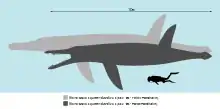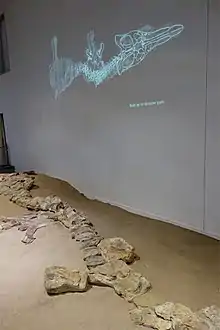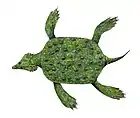Kronosaurus
Kronosaurus (/ˌkrɒnoʊˈsɔːrəs/ KRON-oh-SOR-əs; meaning "lizard of Kronos") is a potentially dubious[2] genus of extinct short-necked pliosaur. With an estimated length of 9 to 10.9 meters (30 to 36 ft), it was among the largest pliosaurs, and is named after the leader of the Greek Titans, Kronos. It lived in the Early Cretaceous period (Aptian to Late Albian).[3][4] Fossil material has been recovered from the Toolebuc Formation (middle to late Albian) and Wallumbilla Formations (Aptian) of Queensland and New South Wales in Australia.
| Kronosaurus Temporal range: Aptian-Late Albian ~ | |
|---|---|
 | |
| K. queenslandicus holotype mandibular symphysis fragment | |
| Scientific classification | |
| Kingdom: | Animalia |
| Phylum: | Chordata |
| Class: | Reptilia |
| Superorder: | †Sauropterygia |
| Order: | †Plesiosauria |
| Family: | †Pliosauridae |
| Subfamily: | †Brachaucheninae |
| Genus: | †Kronosaurus Longman, 1924[1] |
| Type species | |
| †Kronosaurus queenslandicus Longman, 1924[1] | |
Discovery
In 1899, Andrew Crombie of Hughenden discovered a "scrap of bone" containing six conical teeth, and gave this fragmentary fossil to the Queensland Museum. Twenty-five years later, then-director Heber Longman formally described the specimen as the holotype of a new species: Kronosaurus queenslandicus.[1][5] More Kronosaurus material, including a partial skull, was discovered in 1929, in the same location as Crombie's original find.[5]
Taxonomic validity
The validity of Kronosaurus was a longstanding issue due to the fragmentary nature of the holotype. Welles (1962) declared the taxon as a nomen vanum and recommended the designation of a neotype specimen that would preserve the taxon's validity.[6] McHenry (2009) subsequently proposed that two partial skeletons (QM F18827 and QM F10113) that matched the holotype's features and were from its same geological horizon (Toolebuc Formation) could be candidate neotypes.[7] However, no formal petition to the ICZN to designate a neotype was ever submitted. In 2021, Noè and Gómez-Pérez formally restricted Kronosaurus to the holotype. They subsequently erected a new taxon named Eiectus longmani with the Harvard skeleton (MCZ 1285) as its holotype and reassigned all specimens previously referred as K. queenslandicus to it.[2] This move, which was initially interpreted as renaming the entire species to E. longmani, faced criticism by paleontologists. Darren Naish commented that the apparent renaming was "not a good idea"[8] that discourages stability[9] while paleontologist Daniel Madzia dubbed the situation "Kronogate"[10] and criticized the decision to not petition for a neotype.[11] However, the reassignment of all Kronosaurus material to the new taxon is tentative. Noè & Gómez-Pérez (2021) noted the likelihood that the fossils actually represent multiple pliosaur species, meaning that the Toolebuc Formation specimens could be distinct from E. longmani,[2] and previous studies already suggested that the Harvard skeleton might be distinct from K. queenslandicus.[7]
Harvard's completed skeleton

In 1931 the Harvard Museum of Comparative Zoology (MCZ) sent an expedition to Australia for the dual purpose of procuring specimens – the museum being "weak in Australian animals and...desires[ing] to complete its series" – and to engage in "the study of the animals of the region when alive."[12] The Harvard Australian Expedition (1931–1932), as it became known, was a six-man venture led by Harvard Professor William Morton Wheeler, with the others being Dr. P. Jackson Darlington Jr. (a renowned coleopterist),[13][14] Dr. Glover Morrill Allen and his student Ralph Nicholson Ellis,[15] medical officer Dr. Ira M. Dixon, and William E. Schevill (a graduate-student in his twenties and Associate Curator of Invertebrate Palaeontology).[16][12][17] MCZ director Thomas Barbour said at the time "We shall hope for specimens' of the kangaroo, the wombat, the Tasmanian devil and Tasmanian wolf," and the mission was a success with over 300 mammal and thousands of insect specimens returning to the United States.[13][16] Yet Mr. Schevill, the team's fossil enthusiast, remained in Australia after the others had departed and, in the winter of 1932, was told by the rancher R.W.H. Thomas of rocks with something "odd" poking out of them on his property near Hughenden.[5][18][16][19] The rocks were limestone nodules containing the most complete skeleton of Kronosaurus ever discovered.[5][20][21] After dynamiting the nodules out of the ground (and into smaller pieces weighing approximately four tons[22][23]) with the aid of a British migrant trained in the use of explosives,[24] William Schevill had the fossils shipped back to Harvard for examination and preparation. The skull—which matched the holotype jaw fragment of K. queenslandicus—was prepared right away, but time and budget constraints put off restoration of the nearly complete skeleton – most of the bones of which remained unexcavated within the limestone blocks – for 20 years.[20]

This interim ended when they came to the attention of Godfrey Lowell Cabot – Boston industrialist, philanthropist, and founder of the Cabot Corporation – "who was then in his nineties" and "had been interested in sea serpents since childhood."[16] Having formerly questioned MCZ director Alfred Romer about the existence and reports of sea serpents, it thus occurred to Dr. Romer to tell Mr. Cabot about the skeleton in the museum closet. Godfrey Cabot thus asked how much a restoration would cost and "Romer, pulling a figure out of the musty air, replied, 'Oh, about $10,000.'" Romer may not have been serious but the philanthropist clearly was because the check for said sum came shortly thereafter.[16][24] Two years – and more than $10,000 – later, following the careful labor of the museum preparators, the restored and mounted skeleton was displayed at Harvard in 1959.[5][20] However, Dr. Romer and MCZ preparator Arnold Lewis confirmed that same year in the institution's journal Breviora that "erosion had destroyed a fair fraction of this once complete and articulated skeleton...so that approximately a third of the specimen as exhibited is plaster restoration."[25] Furthermore, the original (real) bones are also layered in plaster; a fact that, while keeping the fossils safe, makes it difficult for paleontologists to study it – an issue which factors into the controversial question of the true size of the Kronosaurus queenslandicus.[24]
In 2021, a revision of K. boyacensis also transferred most of the remains of K. queenslandicus, including the Harvard remains, to a new genus and species, Eiectus longmani. The revision limits the genus Kronosaurus to the holotype mandible, and treats it as a nomen dubium.[2]
Size issues
Body-length estimates, largely based on the 1959 Harvard reconstruction, had previously put the total length of Kronosaurus at 12.8 meters (42 ft).[26] However, more recent studies, comparing fossil specimens of Kronosaurus to other pliosaurs suggests that the Harvard reconstruction may have included too many vertebrae, exaggerating the previous estimate, with the true length probably only 9 to 10.9 meters (30 to 36 ft).[4][7] In 2022, the specimens referred to Eiectus longmani were estimated at 10 metres (33 ft) in length and 11 metric tons (12 short tons) in body mass.[27]
Description

Like other pliosaurs, Kronosaurus was a marine reptile. It had an elongated head, a short neck, a stiff body propelled by four flippers, and a relatively short tail. The posterior flippers were larger than the anterior. Kronosaurus was carnivorous, and had many long, sharp, conical teeth. A feature of the genus Kronosaurus is that the first three maxillary teeth are enlarged to fangs.[7] Current estimates put Kronosaurus at around 9 to 10.9 meters (30 to 36 ft) in length.[4][7] In 2009, K. queenslandicus was estimated to weigh about 10.6 to 12.1 metric tons (11.7 to 13.3 short tons).[7] The skull length of Kronosaurus was estimated to be 2.21–2.85 meters (7.3–9.4 ft).[7][28]
All Sauropterygians had a modified pectoral girdle that supported a powerful swimming stroke.[29] Kronosaurus and other plesiosaurs/pliosaurs had a similarly adapted pelvic girdle,[30] allowing them to push hard against the water with all four flippers. Between its two limb girdles was a massive mesh of gastralia (belly ribs) that provided additional strength and support.[30] The strength of the limb girdles, combined with evidence of large, powerful swimming muscles, indicates that Kronosaurus was likely a fast, active swimmer.[30]
Kronosaurus queenslandicus has four pairs of premaxillary teeth. The first three pairs of its maxillary teeth are large caniniform teeth, and in its lower jaw there are also three pairs of large caniniform teeth which are located immediately in front of the three maxillary caniniforms when the mouth is closed. Two pairs of the lower jaw caniniforms occlude between the last pair of premaxillary teeth and first pair of maxillary teeth in a diastema (gap in the tooth row). The enlargement of these two pairs of lower jaw teeth in K. queenslandicus may be related to the absence of a fifth pair of premaxillary teeth, which are present in a number of other pliosaurs.[7]
Teeth
Kronosaurus teeth exceed 7 centimeters (2.8 in) in length (the largest up to 30 centimeters (12 in) long with 12 centimeters (4.7 in) crowns). However, they lack carinae (cutting edges) and the distinct trihedral (three facets) of Pliosaurus and Liopleurodon teeth. The combination of large size, conical shape and lack of cutting edges allows for easy identification of Kronosaurus teeth in Cretaceous formations from Australia.[4][31]
Classification

The cladogram below follows a 2011 analysis by paleontologists Hilary F. Ketchum and Roger B. J. Benson, and reduced to genera only.[32]
| Pliosauroidea |
| ||||||||||||||||||||||||||||||||||||||||||||||||||||||||||||||||||||||||||||||||||||||||||||||||||||||||||||||||||||||||||||||||||||
Palaeobiology

Fossil stomach contents from Northern Queensland show that Kronosaurus preyed on turtles and plesiosaurs. Fossil remains of large octobrachians [34] have been found in the same area as Kronosaurus. While no direct evidence of the animal predating on these octobrachians exists they fall within the projected size range of prey Kronosaurus would potentially have pursued.[7]
Large, round bite-marks have been found on the skull of an Albian-age Australian elasmosaurid (Eromangasaurus) that could be from a Kronosaurus attack.[35][36]
Paleoecology
Kronosaurus is known from remains in Australia. The area was covered by a shallow inland sea called the Eromanga Sea which Kronosaurus inhabited.[37] This environment was notably cold, experiencing near freezing temperatures [38] and seasonal ice in certain regions.[7][39]
See also
- List of plesiosaur genera
- Timeline of plesiosaur research
- Platypterygius
References
- Longman HA. 1924. A new gigantic marine reptile from the Queensland Cretaceous, Kronosaurus queenslandicus new genus and species. Memoirs of the Queensland Museum 8: 26–28.
- Noè, L.F.; Gómez-Pérez, M. (2021). "Giant pliosaurids (Sauropterygia; Plesiosauria) from the Lower Cretaceous peri-Gondwanan seas of Colombia and Australia". Cretaceous Research. 132: 105122. doi:10.1016/j.cretres.2021.105122.
- Hampe O. 1992. Ein großwüchsiger Pliosauride (Reptilia: Plesiosauria) aus der Unterkreide (oberes Aptium) von Kolumbien. Courier Forschungsinstitut Senckenberg 145: 1–32.
- Kear BP. 2003. Cretaceous marine reptiles of Australia: a review of taxonomy and distribution. Cretaceous Research 24: 277–303.
- Mather, Patricia, with Agnew, N.H. et al. The History of the Queensland Museum, 1862–1986 Retrieved from archive.org
- Welles, S.P. (1962). "A new species of elasmosaur from the Aptian of Colombia and a review of the Cretaceous plesiosaurs" (PDF). University of California Publications in Geological Sciences. 44 (1): 1–96. Archived from the original (PDF) on 4 January 2022.
- McHenry, Colin R. 2009. Devourer of Gods: The palaeoecology of the Cretaceous pliosaur Kronosaurus queenslandicus. The University of Newcastle, N.S.W. Australia, Web.
- Darren Naish [@TetZoo] (20 December 2021). "It's happened. Kronosaurus made a nomen dubium, the referred diagnostic stuff now the new taxon Eiectus longmani Noè & Gómez-Pérez, 2021. Immediate instincts are that this is not a good idea" (Tweet) – via Twitter.
- Darren Naish [@TetZoo] (20 December 2021). "It looks like the opposite of a decision that promotes stability, since every statement ever made about Kronosaurus now refers to Eiectus" (Tweet) – via Twitter.
- Daniel Madiza [@danielmadzia] (7 April 2022). "This means that if we want to keep the name Liopleurodon in use (and especially avoid another 'Kronogate'), L. ferox is in need of a detailed reevaluation and an ICZN petition should probably be filed to request that its type is replaced with something diagnostic;" (Tweet) – via Twitter.
- Daniel Madzia [@danielmadzia] (20 December 2021). "Haven't read the paper yet so the authors may discuss this option but petition to ICZN to replace the type seems *much* more appropriate than offering new name for the Kronosaurus material" (Tweet) – via Twitter.
- Gardiner, J. Stanley (September 1931). "The Harvard Museum Expedition to Australia". Nature. 128 (3228): 457–458. Bibcode:1931Natur.128..457G. doi:10.1038/128457c0. S2CID 29715877.
- Capinera, John L. (2008). "Darlington, Jr., Philip J". Encyclopedia of Entomologists. pp. 1153–1154. ISBN 9781402062421.
- A Guide to Stag Beetles of Australia By George Hangay, Roger de Keyzer (p. 139) - https://books.google.com/books?id=CqxWDgAAQBAJ&pg=PA139&lpg=PA139&dq=Harvard+expedition+to+Australia+in+1931&source=bl&ots=z7sMfkRcr3&sig=F82aRX9ZWuNqujfCXBHj90YFs5A&hl=en&sa=X&ved=0ahUKEwjt3Kq1_K3bAhWB7lMKHW0uAJ8Q6AEIWTAF#v=onepage&q=Harvard%20expedition%20to%20Australia%20in%201931&f=false
- Ralph Ellis archives, 1898–1972 – http://etext.ku.edu/view?docId=ksrlead/ksrl.sc.ellisralpharchives.xml Archived 27 December 2019 at the Wayback Machine
- About the Exhibits by Elizabeth Hall and Max Hall (Museum of Comparative Zoology "Agazziz Museum" Harvard University. Third Edition, Copyright 1964, 1975, 1985, by the President and Fellows of Harvard College
- Annual report of the director of the Museum of Comparative Zoology at Harvard College, to the president of Harvard College for 1932–1933. Cambridge, U.S.A.: Printed for the Museum p.54-58 [BHL – https://www.biodiversitylibrary.org/page/41109461#page/58/mode/1up]
- News-Press from Fort Myers, Florida on 26 January 1989 · Page 9 – https://www.newspapers.com/newspage/215995144/
- Bailey, Joyce R. W. H. Thomas : a man of distinction. Joyce Bailey, [Kangaloon, N.S.W, 2005. – https://trove.nla.gov.au/work/19722517?q&versionId=23188287+220283007
- Meyers, Troy. Kronosaurus Chronicles. Australian Age of Dinosaurs, Issue 3, 2005. Retrieved from australianageofdinosaurs.com
- Zoology Museum to Exhibit Largest Sea-Reptile Fossil – https://www.thecrimson.com/article/1956/4/25/zoology-museum-to-exhibit-largest-sea-reptile/
- Rolfe, WD Ian. "William Edward Schevill: palaeontologist, librarian, cetacean biologist." Archives of Natural History 39.1 (2012): 162–164. – https://www.euppublishing.com/doi/pdfplus/10.3366/anh.2012.0069
- 1930s: The One That Got Away – https://australianmuseum.net.au/blogpost/museullaneous/1930s-the-one-that-got-away
- The Rarest of the Rare: Stories Behind the Treasures at the Harvard Museum of Natural History (Hardcover) – 26 October 2004
- Romer, A. S. and A. D. Lewis. 1959. A mounted skeleton of the giant plesiosaur Kronosaurus. Breviora 112:1–15.
- Romer AS, Lewis AD. 1959. A mounted skeleton of the giant plesiosaur Kronosaurus. Breviora 112: 1–15.
- Paul, Gregory S. (2022). The Princeton Field Guide to Mesozoic Sea Reptiles. Princeton University Press. p. 104. ISBN 9780691193809.
- Benson, R. B. J.; Evans, M.; Smith, A. S.; Sassoon, J.; Moore-Faye, S.; Ketchum, H. F.; Forrest, R. (2013). Butler, Richard J (ed.). "A Giant Pliosaurid Skull from the Late Jurassic of England". PLOS ONE. 8 (5): e65989. Bibcode:2013PLoSO...865989B. doi:10.1371/journal.pone.0065989. PMC 3669260. PMID 23741520.
- Palaios – Sauropterygia
- Palaios – Plesiosauria
- Massare JA. 1997. Introduction – faunas, behaviour and evolution. In: Callaway JM, Nicholls EL. (Eds.), Ancient Marine Reptiles. Academic Press, San Diego, pp. 401–421.
- Hilary F. Ketchum and Roger B. J. Benson (2011). "A new pliosaurid (Sauropterygia, Plesiosauria) from the Oxford Clay Formation (Middle Jurassic, Callovian) of England: evidence for a gracile, longirostrine grade of Early-Middle Jurassic pliosaurids". Special Papers in Palaeontology. 86: 109–129.
{{cite journal}}: CS1 maint: uses authors parameter (link) - Schumacher, B. A.; Carpenter, K.; Everhart, M. J. (2013). "A new Cretaceous Pliosaurid (Reptilia, Plesiosauria) from the Carlile Shale (middle Turonian) of Russell County, Kansas". Journal of Vertebrate Paleontology. 33 (3): 613. doi:10.1080/02724634.2013.722576. S2CID 130165209.
- Fuchs, Dirk (2019). "Eromangateuthis n. Gen., a new genus for a late Albian gladius-bearing giant octobrachian (Cephalopoda: Coleoidea)". Paleontological Contributions. 2019 (21): 4. doi:10.17161/1808.29619. S2CID 204976334.
- Sachs S. 2005. Tuarangisaurus australis sp. nov. (Plesiosauria: Elasmosauridae) from the Lower Cretaceous of northeastern Queensland, with additional notes on the phylogeny of the Elasmosauridae. Memoirs of the Queensland Museum. 50 (2): 425–440.
- Kear, B. P. 2007. Taxonomic Clarification of the Australian Elasmosaurid Genus Eromangasaurus, with Reference to Other Austral Elasmosaur Taxa. Memoirs of the Queensland Museum. 27 (1): 241–246.
- Queensland Museum – Kronosaurus
- De Lurio, Jennifer L.; Frakes, L.A. (1999). "Glendonites as a paleoenvironmental tool: implications for early Cretaceous high latitude climates in Australia". Geochimica et Cosmochimica Acta. 63 (7–8): 1039–1048. doi:10.1016/S0016-7037(99)00019-8.
- Alley, N.F.; Hore, S.B.; Frakes, L. A. (2019). "Glaciations at high-latitude Southern Australia during the Early Cretaceous". Australian Journal of Earth Sciences. 67 (8): 1045–1095. doi:10.1080/08120099.2019.1590457. S2CID 155844277.
External links
- Genus Kronosaurus. The Plesiosaur Directory.
 Media related to Kronosaurus at Wikimedia Commons
Media related to Kronosaurus at Wikimedia Commons






.png.webp)


.jpg.webp)
